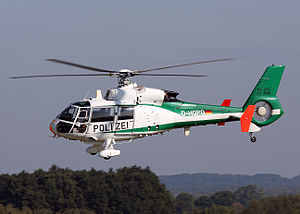Aérospatiale SA 360
| SA 360 Dauphin | |
|---|---|
 |
|
| Aérospatiale Dauphin of the German police | |
| Role | utility helicopter |
| National origin | France |
| Manufacturer | Aérospatiale |
| First flight | 2 June 1972 |
| Introduction | 1976 |
| Produced | 1976-77 |
| Number built | 2 prototypes + 34 production examples |
| Developed into | Eurocopter AS365 Dauphin |
The Aérospatiale SA 360 Dauphin was a single-engine French utility helicopter developed as a replacement for Aérospatiale's Alouette III in the early 1970s and to fill a gap in the company's product line in the six to ten-seat helicopter category. However, as the new helicopter offered little advantage over its predecessor and thus limited market appeal, production of the SA 360 Dauphin was abandoned after only a few dozen of them had been built.
Aérospatiale had also developed a twin-engine derivative, the Dauphin 2, which proved to be quite successful and has been in production for nearly 40 years. After the merger of Aérospatiale's helicopter division into Eurocopter in 1992, the Dauphin 2 designation was dropped, and Eurocopter-built Dauphin 2s are simply referred to as "Dauphin". The retronym "Dauphin 1" is sometimes applied to the original Dauphin.
The Dauphin design was originally derived from the Alouette III it was intended to succeed, and in fact used the rotor blades from that aircraft. Power was provided by a 730 kW (980 hp) Turbomeca Astazou XVI turboshaft, in place of later Alouette IIIs' Astazou XIV. The aircraft featured a fully enclosed cabin with seating for up to nine passengers, a four-bladed main rotor and a thirteen-bladed fenestron in the tail. It was fitted with fixed, tailwheel undercarriage with spatted mainwheels. The first of two prototypes (registration F-WSQL) made its first of 180 test flights in this configuration on 2 June 1972.
Following this initial evaluation, a number of modifications were incorporated into the design. These included increasing engine power by use of an Astazou XVIIIA of 780 kW (1,050 hp), and replacement of the original rotor blades with plastic blades. Aérospatiale engineers hoped to reduce vibration and ground resonance. Thus modified, test flights resumed in May 1973, in time to present the new aircraft at that year's Paris Air Show. In the meantime, a second prototype (registration F-WSQX) joined the test programme, flying first on 29 January. At the show, the first prototype broke three world airspeed records for helicopters in the 1,750 kg - 3,000 kg class (FAI class E-1d). Piloted by Roland Coffignot and carrying a dummy payload to represent eight passengers, it broke the 100 km closed-circuit (299 km/h, 186 mph), 3 km straight-course (312 km/h, 195 mph), and 15 km straight-course (303 km/h, 189 mph) records.
...
Wikipedia
